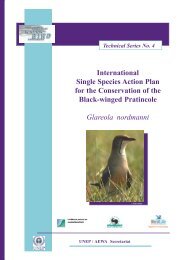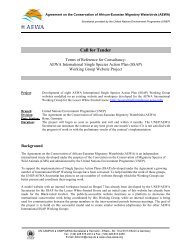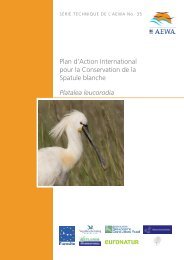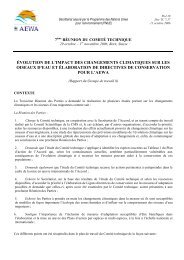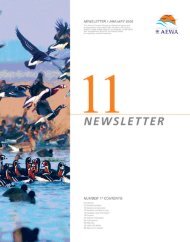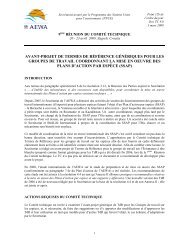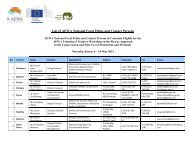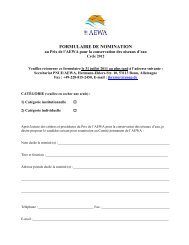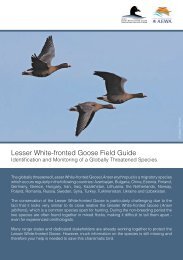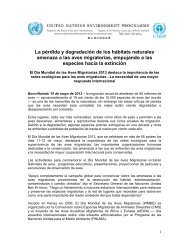International Single Species Action Plan for the ... - AEWA
International Single Species Action Plan for the ... - AEWA
International Single Species Action Plan for the ... - AEWA
Create successful ePaper yourself
Turn your PDF publications into a flip-book with our unique Google optimized e-Paper software.
<strong>AEWA</strong> Technical Series No. 36<br />
2. Ensure that all key sites <strong>for</strong> Lesser White-fronted Goose have a management plan that<br />
addresses <strong>the</strong> conservation requirements of Lesser White-fronted Goose and that is<br />
resourced, implemented, monitored and periodically updated;<br />
3. Monitor habitat quality in <strong>the</strong> breeding range to ensure that any anthropogenic<br />
pressures, including <strong>the</strong> potential impacts of climate change, are identified as early as<br />
possible;<br />
4. Take measures to restore and/or rehabilitate Lesser White-fronted Goose roosting and<br />
feeding habitat in <strong>the</strong> staging and/or wintering range.<br />
These actions are applicable in all of <strong>the</strong> Range States.<br />
Result 3: Reproductive success is maximised<br />
1. Avoid infrastructure development and o<strong>the</strong>r sources of human disturbance, including<br />
recreation/tourism liable to have an adverse impact on <strong>the</strong> know core breeding areas;<br />
2. Take measures to avoid overgrazing and nest trampling if/where this is known to be a<br />
problem;<br />
3. Take measures, where feasible, to minimise predation, where this is shown to be a<br />
significant limiting factor;<br />
4. Take measures to eliminate waterbird hunting on <strong>the</strong> breeding grounds (Russian<br />
Federation and Norway) and in all staging areas close to <strong>the</strong> breeding grounds<br />
(Fennoscandia, Russian Federation).<br />
These actions are applicable in <strong>the</strong> few Range States that share <strong>the</strong> species’ entire breeding<br />
range, namely Finland, Norway, Sweden and Russian Federation.<br />
Result 4: No introgression of DNA from o<strong>the</strong>r goose species into <strong>the</strong> wild population<br />
occurs as a result of fur<strong>the</strong>r releases and introgression from already released birds from<br />
captive breeding programmes is minimised.<br />
As set out in Chapter 3, <strong>the</strong>re has been a lack of consensus among Lesser White-fronted<br />
Goose stakeholders on <strong>the</strong> use of captive breeding, supplementation/reintroduction, and<br />
flyway modification as valid conservation tools to be integrated with measures directed at<br />
conservation of <strong>the</strong> surviving wild population. Proponents have argued that all ef<strong>for</strong>ts to date<br />
have failed to stop or reverse <strong>the</strong> decline of <strong>the</strong> Lesser White-fronted Goose and that<br />
supplementation/reintroduction is <strong>the</strong> only assured means of securing <strong>the</strong> species’ survival,<br />
citing <strong>the</strong> high adult survival rates achieved through diverting <strong>the</strong> flyway through ‘safe’<br />
countries. Opponents have argued that introduction in areas that do not <strong>for</strong>m part of <strong>the</strong><br />
species’ natural range is scientifically and ethically unsound and believe that ef<strong>for</strong>ts and<br />
resources should be devoted to conservation of <strong>the</strong> wild Fennoscandian population as long as<br />
it continues to exist, with supplementation/reintroduction remaining an option if all o<strong>the</strong>r<br />
measures fail. They also highlight <strong>the</strong> risk of introgression of DNA from o<strong>the</strong>r goose species<br />
into <strong>the</strong> wild population, following <strong>the</strong> discovery of such DNA among <strong>the</strong> captive breeding<br />
stock.<br />
As detailed in Chapter 3 (pages 34–35), <strong>the</strong> Scientific Council of <strong>the</strong> Convention on<br />
Migratory <strong>Species</strong> presented a series of conclusions and recommendations on <strong>the</strong>se issues in<br />
November 2005. The full text of <strong>the</strong> Scientific Council’s statement, toge<strong>the</strong>r with relevant<br />
comments made by Dr Robert C. Lacy, can be found in Annexes 9a and 9b, respectively.<br />
The Scientific Council’s findings proved controversial and <strong>the</strong> <strong>AEWA</strong> Secretariat conducted<br />
a series of consultations with <strong>the</strong> key Range States in 2007 resulting in an agreement between<br />
<strong>the</strong> parties concerned. The conclusions set out in this agreement <strong>for</strong>m <strong>the</strong> basis of <strong>the</strong> <strong>Single</strong><br />
<strong>Species</strong> <strong>Action</strong> <strong>Plan</strong>’s approach to this issue. They are detailed on pages 35-37 and in Annex<br />
10. The following is a summary only of <strong>the</strong> key points agreed by <strong>the</strong> parties:<br />
<strong>International</strong> <strong>Single</strong> <strong>Species</strong> <strong>Action</strong> <strong>Plan</strong> <strong>for</strong> <strong>the</strong> Conservation of <strong>the</strong> Lesser White-fronted Goose 52



